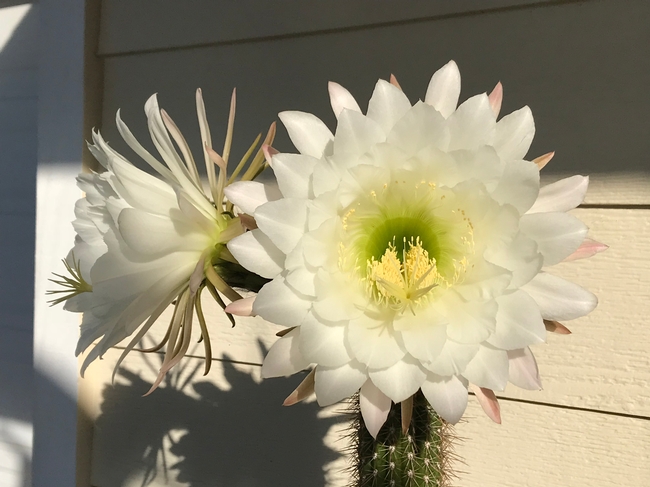Plants We Love
By Jackie Woods UCCE Master Gardener
Common name: Night Blooming Cactus, Golden Torch Cactus, Torch Cactus
Latin name: Echinopsis spaciana
Size of plant: 2 – 2 ¼ inches wide and as tall as 4 - 7 feet.
Bloom description and season: Large, plate-size, white fragrant flowers that bloom only once and usually at night. They bloom when temperatures consistently exceed 70 degrees (F).
Exposure: Full sun to partial shade.
Water needs: Above 70 degrees (F), Echinopsis enjoys regular watering.
USDA Hardiness: 8a, 8b, 9a, 9b, 10a, 10b
Sunset Zone: 12, 13, 16, 17, 21, 22, 23, 24
Description: Torch cactus is a slow growing, long, lean and beautiful cactus native to South America. Characterized by a columnar body with 10 - 15 ribs, Torch Cactus has areoles (small area on cactus that produces hairs or spines) that are 1-2 inches apart along the rib margins with 1-2 cm long spines. Flower arise from the areoles. This particular cactus grows well in areas where temperatures are consistently 70 degrees (F) or greater. Torch cactus prefers well-drained soil, does well in containers and rock gardens and while drought-tolerant, prefers regular watering, especially during its blooming season. Blooming in the spring, the stunning, large flower blooms at the end of a trumpet-shaped stalk and opens at night, day, or both, but only lasts for one day. The nocturnal flowering habit suggests adaptation to moth and bat pollinators. Torch Cactus tolerates colder temperatures and even seem to enjoy it, but they must be sheltered from freezing temperatures as their water-filled bodies will freeze. Torch cactus can be propagated by removing the cactus offset or ‘pup' and transplanting. Offsets should be allowed to callus prior to planting in a pot of cactus soil mix or well-draining gritty medium. The container need be just slightly bigger than the offset. Take care to cover one-third to one-half of the base with soil. Keep in indirect, bright sunlight and water enough to keep the soil slightly moist.
